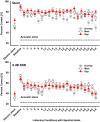Frequency importance functions in simulated bimodal cochlear-implant users with spectral holes
- PMID: 38829154
- PMCID: PMC11151433
- DOI: 10.1121/10.0026220
Frequency importance functions in simulated bimodal cochlear-implant users with spectral holes
Abstract
Frequency importance functions (FIFs) for simulated bimodal hearing were derived using sentence perception scores measured in quiet and noise. Acoustic hearing was simulated using low-pass filtering. Electric hearing was simulated using a six-channel vocoder with three input frequency ranges, resulting in overlap, meet, and gap maps, relative to the acoustic cutoff frequency. Spectral holes present in the speech spectra were created within electric stimulation by setting amplitude(s) of channels to zero. FIFs were significantly different between frequency maps. In quiet, the three FIFs were similar with gradually increasing weights with channels 5 and 6 compared to the first three channels. However, the most and least weighted channels slightly varied depending on the maps. In noise, the patterns of the three FIFs were similar to those in quiet, with steeper increasing weights with channels 5 and 6 compared to the first four channels. Thus, channels 5 and 6 contributed to speech perception the most, while channels 1 and 2 contributed the least, regardless of frequency maps. Results suggest that the contribution of cochlear implant frequency bands for bimodal speech perception depends on the degree of frequency overlap between acoustic and electric stimulation and if noise is absent or present.
© 2024 Acoustical Society of America.
Conflict of interest statement
The authors declare that the research was conducted in the absence of any commercial or financial relationships that could be construed as a potential conflict of interest.
Figures


Similar articles
-
Overlapping frequency coverage and simulated spatial cue effects on bimodal (electrical and acoustical) sentence recognition in noise.J Acoust Soc Am. 2014 Feb;135(2):851-61. doi: 10.1121/1.4861843. J Acoust Soc Am. 2014. PMID: 25234893
-
Electric and acoustic harmonic integration predicts speech-in-noise performance in hybrid cochlear implant users.Hear Res. 2018 Sep;367:223-230. doi: 10.1016/j.heares.2018.06.016. Epub 2018 Jun 28. Hear Res. 2018. PMID: 29980380 Free PMC article.
-
The effect of a coding strategy that removes temporally masked pulses on speech perception by cochlear implant users.Hear Res. 2020 Jun;391:107969. doi: 10.1016/j.heares.2020.107969. Epub 2020 Apr 10. Hear Res. 2020. PMID: 32320925 Free PMC article.
-
Interactions Between Slopes of Residual Hearing and Frequency Maps in Simulated Bimodal and Electric-Acoustic Stimulation Hearing.J Speech Lang Hear Res. 2024 Jan 8;67(1):282-295. doi: 10.1044/2023_JSLHR-22-00629. Epub 2023 Dec 13. J Speech Lang Hear Res. 2024. PMID: 38092067 Free PMC article.
-
Effects of the Configuration of Hearing Loss on Consonant Perception between Simulated Bimodal and Electric Acoustic Stimulation Hearing.J Am Acad Audiol. 2021 Sep;32(8):521-527. doi: 10.1055/s-0041-1731699. Epub 2021 Dec 29. J Am Acad Audiol. 2021. PMID: 34965598 Free PMC article.
References
-
- Alexander, J. M. , Kopun, J. G. , and Stelmachowicz, P. G. (2014). “ Effects of frequency compression and frequency transposition on fricative and affricate perception in listeners with normal hearing and mild to moderate hearing loss,” Ear. Hear. 35(5), 519–532.10.1097/AUD.0000000000000040 - DOI - PMC - PubMed
-
- Canfarotta, M. W. , Dillon, M. T. , Buss, E. , Pillsbury, H. C. , Brown, K. D. , and O'Connell, B. P. (2020). “ Frequency-to-place mismatch: Characterizing variability and the influence on speech perception outcomes in cochlear implant recipients,” Ear. Hear. 41(5), 1349–1361.10.1097/AUD.0000000000000864 - DOI - PMC - PubMed
Publication types
MeSH terms
Grants and funding
LinkOut - more resources
Full Text Sources
Medical
Miscellaneous

